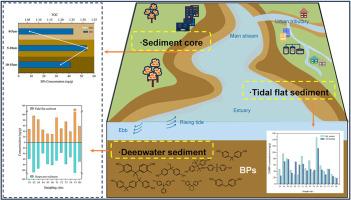珠江盆地潮滩和深水沉积物中10种双酚类似物的赋存状态
IF 7.3
2区 环境科学与生态学
Q1 ENVIRONMENTAL SCIENCES
引用次数: 0
摘要
双酚类似物(BPs)是一种已知的内分泌干扰物,由于其广泛使用和潜在的生态风险而引起越来越多的关注。尽管如此,有限的研究集中在河流沉积物中的bp。本文对珠江流域不同沉积类型(潮滩和深水)的10个bp进行了研究。分析了7个站点0 ~ 15 cm深度的沉积物样本,探讨了bp的垂直剖面。滩涂沉积物中bp总浓度(Σ10BPs)无明显季节变化,枯水期为20.8 ~ 148.1 ng/g,丰水期为18.1 ~ 112.5 ng/g。从空间上看,河口沉积物中bp的平均浓度最低,而城市盆地沉积物中bp的污染程度较高。深水沉积物的BP浓度(平均为72.9 ng/g)高于相应的潮滩沉积物(平均为65.5 ng/g),这可能是由于潮滩环境具有更有利的生物降解条件。沉积物柱中BP浓度范围为12.1 ~ 93.8 ng/g。垂直剖面显示,中层(5 ~ 10 cm)的BP水平普遍高于上层(0 ~ 5 cm)和深层(10 ~ 15 cm)。BPA与潮滩沉积物中总有机碳(TOC)呈显著正相关。基于风险商(RQ)的环境风险评价结果表明,珠江沉积物中BP混合物对鱼类、藻类和甲壳类具有中低风险,其中甲壳类最敏感。据我们所知,这是第一次报道在河流的潮汐和深水沉积物中出现bp的研究。本文章由计算机程序翻译,如有差异,请以英文原文为准。


Insights into the occurrence of ten bisphenol analogues in tidal flat and deepwater sediments in the Pearl River Basin
Bisphenol analogues (BPs), known endocrine disruptors, have raised increasing concerns due to their widespread use and potential ecological risks. Despite this, limited studies have focused on BPs in river sediments. In this study, we investigated ten BPs in different sediment types, including tidal flat and deepwater, across the Pearl River Basin. Sediment samples from the 0–15 cm depth at seven sites were also analyzed to investigate the vertical profile of BPs. In tidal flat sediments, no significant seasonal variation was observed in the total concentration of BPs (Σ10BPs), with values ranging from 20.8 to 148.1 ng/g in the dry season and 18.1–112.5 ng/g in the wet season. Spatially, the average concentration of BPs was lowest in estuarine sediments, while higher pollution levels were found in urban basin sediments. Deepwater sediments showed a higher BP concentration (average: 72.9 ng/g) compared to the corresponding tidal flat sediments (average: 65.5 ng/g), likely due to more favorable biodegradation conditions in tidal flat environments. The BP concentrations in sediment columns ranged from 12.2 to 93.8 ng/g. The vertical profile revealed that mid-layer sediments (5–10 cm) generally exhibited higher BP levels than those in the top (0–5 cm) and deeper (10–15 cm) layers. BPA showed significant positive correlations with total organic carbon (TOC) in tidal flat sediments. Environmental risk assessments based on the risk quotient (RQ) indicated that BP mixtures in Pearl River sediments posed low to medium risks to fish, algae, and crustaceans, with crustaceans being the most sensitive. To our knowledge, this is the first study to report the occurrence of BPs in tidal and deepwater sediments of a river.
求助全文
通过发布文献求助,成功后即可免费获取论文全文。
去求助
来源期刊

Environmental Pollution
环境科学-环境科学
CiteScore
16.00
自引率
6.70%
发文量
2082
审稿时长
2.9 months
期刊介绍:
Environmental Pollution is an international peer-reviewed journal that publishes high-quality research papers and review articles covering all aspects of environmental pollution and its impacts on ecosystems and human health.
Subject areas include, but are not limited to:
• Sources and occurrences of pollutants that are clearly defined and measured in environmental compartments, food and food-related items, and human bodies;
• Interlinks between contaminant exposure and biological, ecological, and human health effects, including those of climate change;
• Contaminants of emerging concerns (including but not limited to antibiotic resistant microorganisms or genes, microplastics/nanoplastics, electronic wastes, light, and noise) and/or their biological, ecological, or human health effects;
• Laboratory and field studies on the remediation/mitigation of environmental pollution via new techniques and with clear links to biological, ecological, or human health effects;
• Modeling of pollution processes, patterns, or trends that is of clear environmental and/or human health interest;
• New techniques that measure and examine environmental occurrences, transport, behavior, and effects of pollutants within the environment or the laboratory, provided that they can be clearly used to address problems within regional or global environmental compartments.
 求助内容:
求助内容: 应助结果提醒方式:
应助结果提醒方式:


